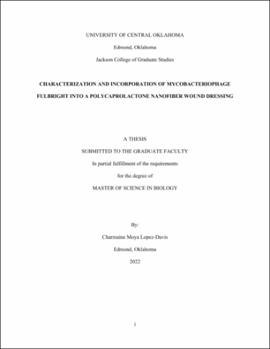| dc.contributor.advisor | Kotturi, Hari | |
| dc.contributor.author | Lopez-Davis, Charmaine M. | |
| dc.date.accessioned | 2022-08-24T19:32:11Z | |
| dc.date.available | 2022-08-24T19:32:11Z | |
| dc.date.issued | 2022 | |
| dc.identifier.other | (AlmaMMSId)9982882505002196 | |
| dc.identifier.uri | https://hdl.handle.net/11244/336502 | |
| dc.description.abstract | Nontuberculous mycobacteria infections such as Mycobacterium abscessus have become a growing concern due to the emergence of multidrug-resistant bacteria, making treatment of infections difficult. Bacteriophages, or phages, are viruses that can infect bacterial cells without harming eukaryotic cells. Bacteriophage therapy is a potential alternative for treating mycobacterial skin infections as phages only kill their bacterial host, leaving the normal flora unharmed. Mycobacteriophage Fulbright was characterized and determined to possess qualities suitable for phage therapy. Fulbright remained stable at temperatures 20-60°C and pH 4-9. The replication cycle took approximately 3 hours to complete, with a 90-minute latent phase. At high titer concentrations, Fulbright was able to lyse M. abscessus, a human pathogen. Fulbright was incorporated into polycaprolactone (PCL) fibers to serve as a model antibacterial wound dressing. PCL_Fulbright effectively reduced the concentration of M. smegmatis and was observed to be non-toxic to fibroblast cells. Incorporated into the PCL fiber, the phage was stable for up to 11 months when stored at -20°C. This project is notable because it was the first mycobacteriophage incorporated into a nanofiber for phage therapy applications and serves as a foundation for future projects. | en_US |
| dc.rights | All rights reserved by the author, who has granted UCO Chambers Library the non-exclusive right to share this material in its online repositories. Contact UCO Chambers Library's Digital Initiatives Working Group at diwg@uco.edu for the permission policy on the use, reproduction or distribution of this material. | |
| dc.subject.lcsh | Bacteriophages | |
| dc.subject.lcsh | Therapeutic use | |
| dc.subject.lcsh | Type specimens | |
| dc.subject.lcsh | Bandages and bandaging | |
| dc.subject.lcsh | Technological innovations | |
| dc.subject.lcsh | Mycobacterial diseases | |
| dc.subject.lcsh | Treatment | |
| dc.subject.lcsh | Wounds and injuries | |
| dc.subject.lcsh | Antibacterial agents | |
| dc.title | Characterization and incorporation of Mycobacteriophage Fulbright into a polycaprolactone nanofiber wound dressing | en_US |
| dc.type | Academic theses | |
| dc.contributor.committeeMember | Morshed, Khandaker | |
| dc.contributor.committeeMember | Olson, Paul | |
| dc.thesis.degree | M.S., Biology | |
| dc.subject.keywords | Bacteriophage | |
| dc.subject.keywords | Mycobacteriophage | |
| dc.subject.keywords | Mycobacterium | |
| dc.subject.keywords | Nanofiber | |
| dc.subject.keywords | Polycaprolactone | |
| dc.subject.keywords | Virology | |
| dc.identifier.oclc | (OCoLC)1347403100 | |
| thesis.degree.grantor | Jackson College of Graduate Studies | |
